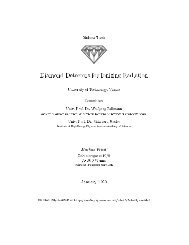You also want an ePaper? Increase the reach of your titles
YUMPU automatically turns print PDFs into web optimized ePapers that Google loves.
oards making up the GT and sends the to the DAQ system. There are two ROPchips on the GTFE board, one for the DAQ system and the other connected to theDAQ Event Manager (EVM). While technically similar, their readout records containdifferent subsets of the trigger information.Timing BoardThe Timing (TIM) board broadcasts clock signals received from the TTC system.This includes the L1A signals distributed through the TCS that initiate the readoutprocess.4.4 Trigger Control SystemThe Trigger Control System (TCS) acts as an intermediate between the GT and therest of the CMS systems. Upon receipt of a positive FINOR verdict, it distributes theL1 accept signal to the different subsystems through the Trigger Timing and Controlsystem (TTC). Even though the trigger subsystem could in principle operate withoutdead time, the fact that the readout of an entire event takes significantly longer than asingle bunch crossing precludes triggering on each bunch crossing in reality. To avoidoverloading the DAQ system, the TCS implements a combination of hard limits onL1A, so-called “trigger rules” (no more than 1 L1A in 3 bunch crossings, 2 in 25, 3in 100, 4 in 240) and a “backpressure” system, where the TCS is notified when bufferspace is running out and suppresses triggers until the situation improves.4.5 Online SoftwareThe trigger electronics are represented as a single subsystem to the central CMS runcontrol software (RCMS, see section 3.2.10). Since the actual hardware spans manyorganizations and electronics crates, however, a distributed control system is necessary.All online software used by the subsystems is based on the Trigger Supervisor(TS)C++ framework, which in turn relies on the CMS-wide XDAQ framework.The basic autonomous unit of the TS framework is an application called a Cell.Each cell provides a web interface featuring both a browser-based user interface andan API using SOAP. TS cells also provide channels to interact with other cells. Forintegration with the RCMS system, a single central cell represents the entire triggersubsystem.Subsystem developers specialize their TS cells through three principal extensionmechanisms:• Commands can be specified which take a number of predefined parameters andreturn a data stream and/or error and warning information. These can be invokedfrom a generic user interface, through the SOAP API or from inside thecell C++ code.47












